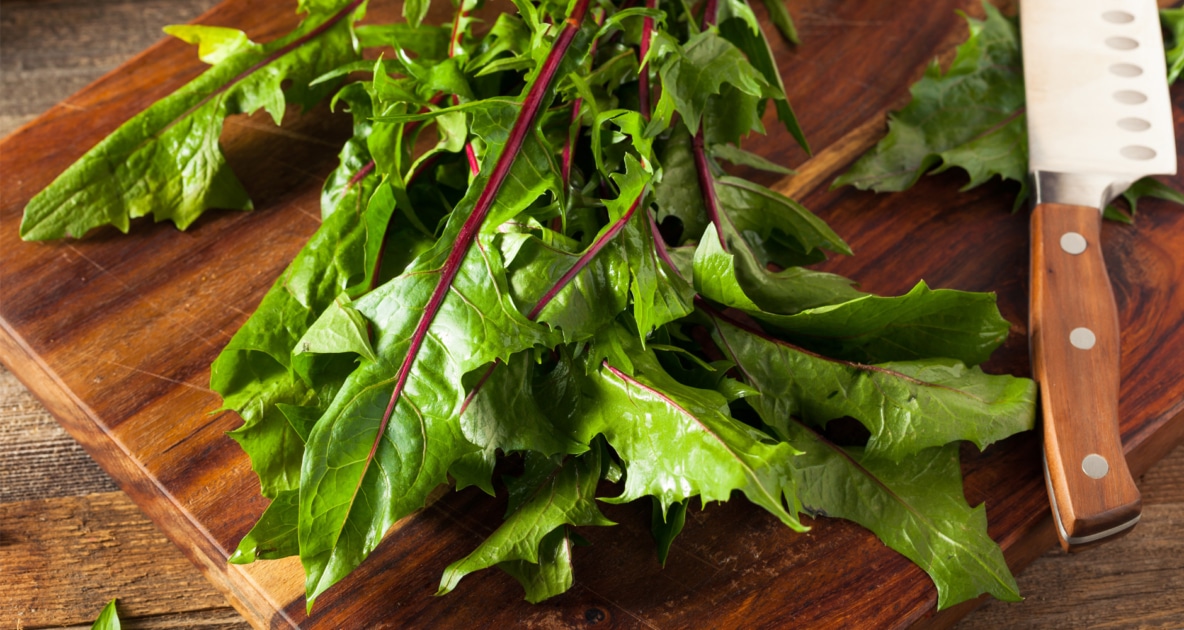Dandy Dandelions: More Than A Weed
A weed to some, but this sunny springtime gem is completely edible and packed with nutrients. Plus, it makes a delicious wine! Learn more, and get the recipe!

If you’re an adventurous eater, the obvious choice for fresh flavor is growing all around you. The ubiquitous dandelion, Taraxacum officinale, may be a pesky weed to some, but it’s totally edible, astoundingly nutritious, and discerningly delicious. In fact, dandelion greens are a good prebiotic, meaning they help increase the friendly bacteria in the gut and boost the immune system.
Edible Dandelions
Raw or cooked, dandelions are ready for consumption. They can be sautéed, or baked into bread, transformed into a tea, or sipped as wine. And they’ve got an added bonus of being nutritious. In fact, the dandelion has been eaten and used medicinally for over 1,000 years. In this day and age of science, how did its goodness get lost in the shuffle?
Are Dandelions Nutritious?
Aptly nicknamed Lion’s Tooth, this sunny little perennial packs a fierce cache of nutrients. It contains more calcium than a glass of milk, more iron than spinach, has loads of vitamin K for your blood and bones, and important minerals, like potassium, folic acid, and magnesium. Plus, dandelions act as a diuretic and are full of fiber. The best part is they’re easy on the budget too—foraging is free! Just make sure you collect them from an area that you know is free of any weed-killing chemicals.
If you’re going for just the greens, you can often find them in the grocery store or farmers market. But if you’re going to gather your own the best tasting leaves are the youngest ones found in early spring before the plant flowers. Obviously, avoid leaves that have wilted or turned yellow or have spots. At home, give them a white vinegar and water bath to kill bacteria. Then rinse and pat them dry, wrap them in a paper towel and store in a plastic bag; they’ll stay fresh for a few days.
How To Cook With Dandelions
Add the raw greens to any salad, or use as a garnish. Because dandelion leaves tend to be on the bitter side, they are perfect sautéed with a little olive oil and garlic. Squeeze a little lemon or even vinegar on top and you have a side dish. Or add the sautéed greens to a sausage, pasta and pine nuts combo for a classic main course. Don’t forget the grated Parmesan!
If you’ll be cooking with the flower of the plant, you’ll want to take some extra time to dismantle and rinse them clean of any stowaway bugs or debris.
Recipes for the flower petals include everything from jam to cookies to bread. But my personal favorite is dandelion wine, which my grandmother used to make. My father claims the first time he was introduced to his future mother-in-law, she served him her homemade dandelion wine. After the first sip, that was the moment he fell in love with my mother. How can you resist making something so romantic?

Dandelion Wine Recipe
Ingredients:
3 quarts dandelion blossoms
1 gallon water
2 oranges, with peel, preferably organic
2 lemons, with peel, preferably organic
3 pounds sugar
1 package wine yeast
Directions:
Collect the blossoms in the morning when they are fully open. Clean thoroughly and drain. For a more delicate flavor, separate the petals from the green base.
Bring the water to a boil and pour it over the flowers in a large pot. Cover and let steep for 24-48 hours.
Peel the rind off lemons and oranges. Remove white pith, which will add bitterness. Slice the remaining fruit. Add the orange and lemon peels to the flower-water mixture and bring to a boil.
Remove from heat, strain out solids, then add the sugar, stirring until it is dissolved. Allow to cool. Add the remaining fruit slices, yeast, and cover with cheesecloth to ferment. When the mixture has stopped bubbling (anywhere from 2 days to three weeks), fermentation is complete. Strain the liquid through several layers of cheesecloth and transfer to sterilized bottles. Cork the bottles and store in a cool, dark place for at least six months before drinking for best flavor.

Christina Carr
Christina Carr is a freelance writer and television producer who has worked for NASA, PBS and John Edward, the psychic medium. She is a proponent of sustainable and healthy living, and lives in NYC with her 4-year-old daughter and musician husband.





Just curious… this would be my first wine. What if i added honey?
MayDay will be here soon. I enjoys a glass of Mead {Wine made from Honey} Its for good luck
The zest is the rind of the fruit. What are you adding the zest or the juice?
Hi DeeDee, you add the peels, then the fruit slices. We have fixed the story to clarify. Sorry for any confusion.
Where do you find wine yeast?
I’ve made many batches of homemade wine with excellent results using ordinary bread yeast, not the quick or fast rise variety.
Toni, it has to be wine yeast.
Does it have to be wine yeast or can you use just regular yeast?